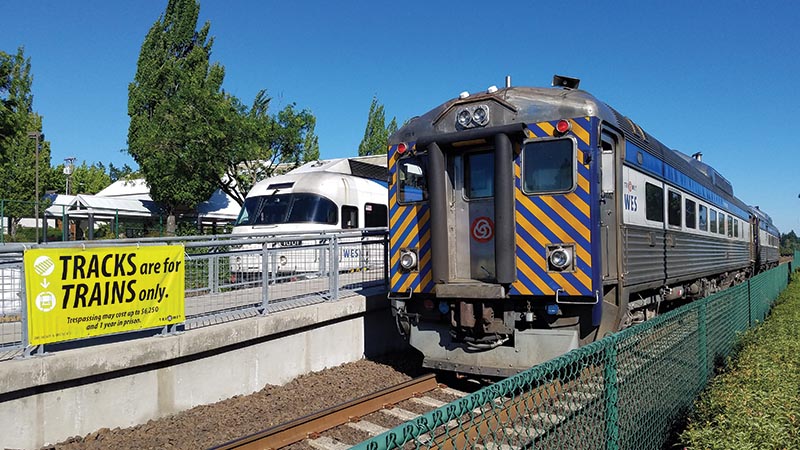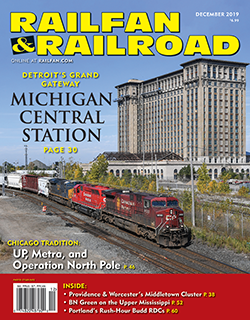 By Alexander Benjamin Craghead/photos as noted
By Alexander Benjamin Craghead/photos as noted
It’s just past five o’clock, the middle of rush hour. You are standing on a modern concrete platform, with all the trappings of contemporary transit, from the line of bright yellow anti-skid pads, to displays showing real-time departure data, to eccentric public art. This is Beaverton, a suburb of Portland, Ore., and you arrived here from the airport aboard one of TriMet’s sleek Siemens S70 light rail vehicles delivered only four years ago. To get to your final destination in the southwestern suburbs, however, you’ll need to transfer to the 14.1-mile-long Westside Express Service (WES) commuter rail line.
A horn blares in the distance, and then you hear bells from the nearby crossing gates as the WES train approaches from the south. When it finally heaves into sight around the corner of a strip mall, you are surprised. Expecting smoothed-over, jelly bean modernism of the early 21st century, instead your train is bulky and squared-off, a symphony of stainless steel fluting and blue-green glass, its face painted in blue and yellow stripes.
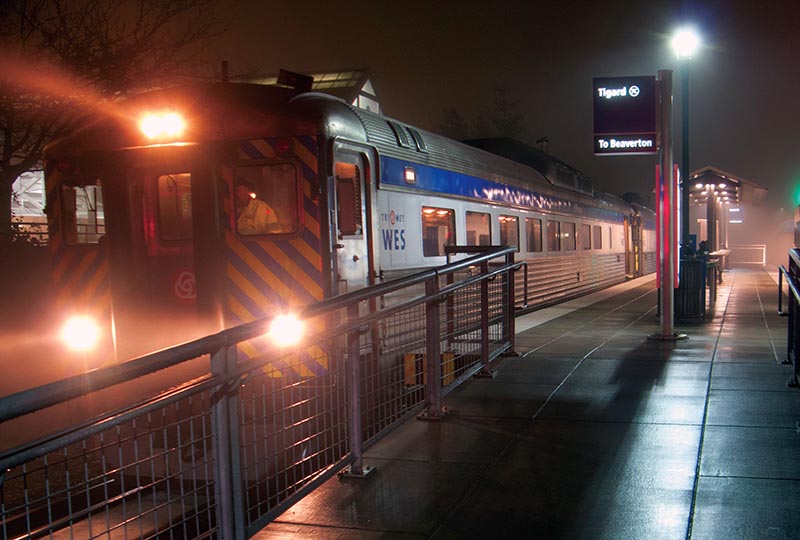
Performing the exact job they were designed to do more than 60 years ago, the Budd RDCs are greeted by a misty rain on one of their first revenue runs on January 24, 2011. —Alexander B. Craghead photo
These cars, TMTC 1702 and 1711, are Budd Rail Diesel Cars (RDCs) built in 1952 and 1953 respectively. These self-propelled passenger cars were delivered to New York, New Haven & Hartford, and they show their age, not in wear and tear as much as in tone and attitude. There’s a weird sense of time displacement, as if stepping from the platform into these cars would be to step from 2019 into 1959.
Alongside two more RDCs presently being rebuilt at the WES shops in Wilsonville, half of TriMet’s commuter rail fleet is made of these cars born late in the Streamliner age. Presently, this makes WES the last transit operation in North America operating the RDC, equipment first developed and delivered by Budd more than 60 years ago. What led TriMet to choose this robust, classic design over more modern offerings?
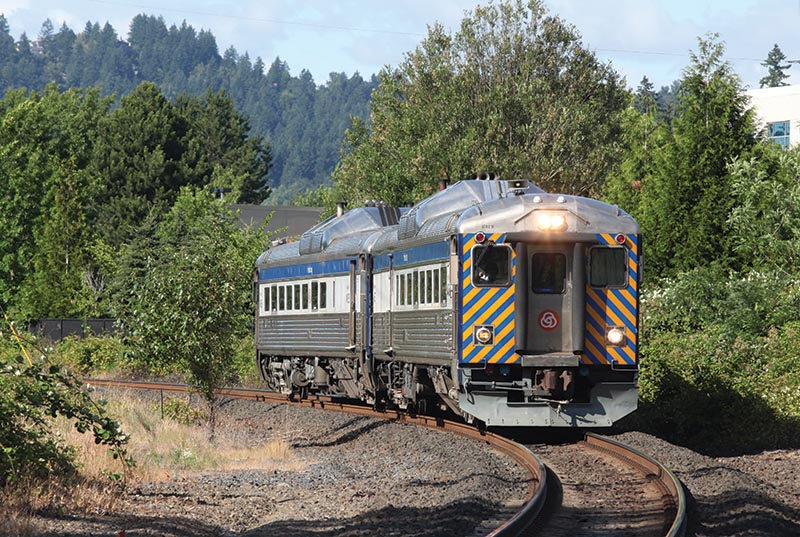
A WES train approaches Bonita Road in Tigard. TriMet’s Budd RDC’s provide a reliable augment to its DMU fleet, but how long will they last? —Randy Nelson photo
Suburb-to-Suburb Commuter Rail
To answer this question, it is first necessary to understand WES itself, one of the most unusual commuter rail operations in the U.S. The story goes back to the 1990s, to suburban Washington County, an archipelago of former commuter towns that had grown into a concentration of tract homes and high-tech manufacturing. The list of employers reads like a who’s who of high tech, including Tektronix, Intel, Epson, HP, Xerox, and several others. In the 1990s, TriMet expanded its Metropolitan Area Express (MAX) light rail system into the county, connecting Hillsboro and Beaverton to downtown Portland, but leaving out communities at the south end of the county where many tech workers lived and, increasingly, where tech companies were building new plants. And, like most suburban environments, highway traffic was unbearable and only getting worse.
Political leaders in Washington County began to advocate for an unusual solution — a suburb-to-suburb commuter rail service operating over existing freight tracks of Portland & Western Railroad, a short line comprised of former branch lines. At a minimum, it would connect several communities to the MAX system, with talk of operating trains all the way from Hillsboro to Salem, more than 50 miles away. Best of all, because it was based on existing rail lines operated by P&W, the costs for construction would be many orders of magnitude lower than the region’s light rail system.
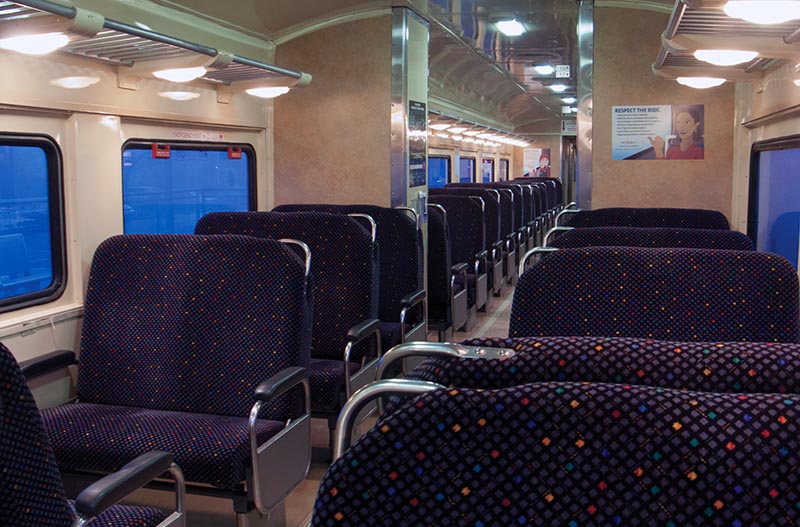
The interiors of the Budd RDCs have been beautifully refurbished, preserving their mid-century design with modern refinements. —Alexander B. Craghead photo
Timing, however, never worked out. A slow planning process meant ideas did not coalesce into a tangible project until the early years of this century. Each year of delay meant construction costs rose while available funds shrank. A global construction boom drove up the price of concrete and steel. The inclusion of a cab signal system necessitated the installation of new equipment in nearly every locomotive in the P&W fleet, an unanticipated public expense.
Equipping WES proved to be another blow to the system. The plan was to operate with modern diesel multiple units (DMUs). In the early 2000s, however, there were relatively few DMUs on the market. Sprinter service in Oceanside, Calif., used European-style DMUs, but these were not FRA crash-compliant and could not be operated mixed in with freight traffic. Bombardier proposed developing a crash-compliant DMU but never fully committed to the idea. At the time, only one builder, Colorado Railcar, made a DMU suitable for the service, so TriMet put in an order. As a result of financial troubles, Colorado Railcar went out of business during the middle of building TriMet’s cars.
The result was a further delay in the opening of the system, and further costs to TriMet as the agency was then forced to effectively take over Colorado Railcar to ensure delivery of the cars. With the three power cars (TMTC 1001–1003) and one unpowered trailer (TMTC 2001) finally on the property, TriMet opened the system in February 2009, five months late, $45 million over budget, and smack in the middle of the Great Recession…


